If one thinks of the Sahara one conjures up pictures of amazing dunes, a vast sea of gilded sand, the muffled footsteps of camels in the silence of the Great Erg. But the Sahara is much more than this - it is Berber villages clinging to steep mountain sides, ksars hewn out of the very rock, cave dwellings such as those at Matmata... Vastness and variety are the keynotes of life in the Sahara. Further to the south, the horizon melts away into the immense desert of dunes and mirages. Any explorer will be thrilled by the breathtaking charm of the fabulous scenery.
Matmata
The World of the Cave
Dwellers
Anyone who visits Tunisia and doesn't take the opportunity to visit
Matmata will miss seeing a type of architecture which is unique - cave
dwellings. Matmata, made up of several villages, takes its name from the
Berber tribes who have taken refuge in this isolated region. The Bergers,
who nowadays are somewhat influenced by Arab culture, still live in
villages carved out the mountainside. Others hide away in underground
dwellings or rifts in the valley. To the south of Gabès, barren ochre
mountains rise up to 700 meters in height. The conical summits are
intersected and separated by precipitous narrow ravines where figs,
olives, barely and some stunted palms grow. The villages are inhabited by
a hardworking people. An unsuspecting eye would look at the village and
only see the craters which hide the houses and create a lunar landscape.
The American film producer Steven Spielberg used this landscape to great
effect in his famous films "Star Wars" and "Raiders of the
Lost Ark". These invisible villages are made up of several cave
dwellings hidden in the ground, which resembles a lunar landscape riddled
with giant holes. In fact, every crater is a house. A tunnel permits
access to a kind of "well", a genuine circular crater hollowed
out of of the hill top, surrounded by rooms for living and storage
excavated out of the ground. The entrance tunnel is lined with stables and
places for storing tools and gives on to a round courtyard. The steep
walls of the "patio" are heavily indented with the niches which
form the living quarters, the food stores and the communal rooms. The
upper parts of the rooms, which often can only be reached by a rope, are
used as granaries. Cereals can be fed into here through a narrow pipe for
the outside. Huge grain stores are piled up in the courtyard, fenced in by
esparto grass. The individual niches are extremely well air conditioned,
cool when the temperature exceeds 40 degrees Centigrade and warm in
winter. Just 40 km away from the sea, and 400 m above sea level, Matmata
enjoys pure, dry air. The inhabitants are noted for their longevity and
good health. If Matmata is considered to be a typical cave dwellers'
village, for several kilometers in every direction the ground shelters
other similar villages such as Beni Aissa, Cembali, Techine and Hedege,
which are perhaps more "genuine" since they receive less
visitors.
They may appear deserted
with their fantastic citadels hewn out of the greyish, craggy rock face
under a burning sun, and indeed some are, by many harbour life, including
Cheninni, Douiret, Ghomrassen, and Guermassa. Subtle and not at all
anxious to reveal its beauty, the Berber village only makes itself known
little by little. But just as with the fiancée in the "Cantiques des
cantiques", all the beauty is contained within. From a well of light,
the Berber villages gradually reveal them selves. Perched on the rim of a
semi-circular ridge, one could imagine this village being topped with
battlements or protected by other ancient fortifications. The dun-coloured
bulk of the ancient Ksar and ruined Ghorfa juts up into the blue sky. A
mosque balances precariously on the hillside. At first vaulted recesses
carved out by the elements are difficult to make out from the reddish
tinge of the mountain, but it is here that the outlines of doorways
literally seem to form a chain about the mountain slopes. On the ridges,
the Berber villages are arranged in tiers on the mountainside, dotted with
dwellings like a vast termite mound. Everything here is picturesque,
imposing and grandiose, with the pride of the Berbers. In the ridge
villages you will visit the ksars, the most well-filled granaries in the
south. Oil stores are hewn out of the mountainside, where in a press made
of a huge stone trough, an enormous mill wheel turned by a blind camel
crushes olives. From these villages on high you can admire the surrounding
region and ask yourself, which is more beautiful the ruined ksars glowing
in the light of the setting sun, or the camel caravan returning against a
sunlit backdrop from pasture on the other side of the mountain. The women
dressed in pink, red and black add a lively splash of color to this
strange scenery. With pleasure they will spread before you the carpets
which they have taken days to weave, every stitch coloured by hand.
Les Ksars
- Castles of the Desert
You come across some
strange and sometimes mysterious buildings in the Great South. These are
the castles of the desert known as KSARS, which can be divided, according
to where they are found, as plain ksars or mountain ksars. How they are
built identifies them as being either Arab or Berber ksars.
The Ksar or Gasr is a king of square building made up of cells added on,
or non-ghorfa, where the local inhabitants would store their produce in
times of unrest, safe from raids. It could be used as a refuge and in
times of peace it became, as did the granary, a focal point for social
life. Trade, daily markets, and meetings were held at the ksar, but they
were never lived in. The ksar also fulfilled other roles, as did Roman
fortifications. It became the location for festivals and teaching; in
short for all social and religious organization. Ksars can be
distinguished by their location, on flat ridges or in sheltered valleys,
and by their layout. The choice of site was made so as to confer strategic
advantages, making it difficult for unwanted strangers to get into the
community. Lookout points permitted surveillance of the surrounding area.
Dotted about in the mountains or scattered on the plains, you can visit
the Ksar Oulad Soltane at Jebel Abiodh, the Ksar Joumaa at Jebel Demer,
the Ksar Khérafcha and the Ksar Hallouf. The Ksar Hadada which is very
well preserved has been turned into an hotel where comfort contrasts
strikingly with the originality of the Berber surroundings. Others are
grouped together at Médenine or Métameur, or isolated such as Ksar Oulad
Debbab and Ksar Kirchaoua.
Women's Hands
In the Tunisian south,
women's hands are able magically to transform colours into the materials
and precious objects. The handicraft skills of the Bedouin are as natural
to them as their nomadic existence. Saharan women and the women of the
ksars use horizontal warp and weft looms. Their tatooed hands weave the
big Ghrara grain sacks and the long single strip Filij bands which, when
interwoven, from the Bedouin tent. Each tribe has its own designs. In this
way they can identify each caravan from a distance. The Berber woman from
the ridge villages uses the upright long weft loom. She weaves her
husband's Burnous on it, as well as her own Bakhnoug, a long piece of
cloth which she uses as a veil, to cover her head and half her body. Each
region has its own colours; wine red for Douiret, black for Guermassa and
blue for Matmata and Tataouine.
Exotica on a Grand Scale
Not every vast empty space is necessarily desert. In the Tunisian south, you don't have to travel far before you're right in the middle of the Sahara. At Douz, an old town with some special characteristics, home to the warlike M'razig tribes, the Sahara is right on your hotel doorstep. The desert is there, all about you. It surrounds and envelops you. The panorama spread out before you fills the lungs and the ears with an immensity which doesn't oppress or weigh you down, but somehow attracts you. In the vastness, the silence is absolute and the immensity of it all calls to you. So why worry? Call out? But the desire to plunge into the desert remains. The desert isn't the ocean, there are no beacons or mornings. The further you go on the roads which vanish with the hours, the less you are able to draw up a definite itinerary. The Méharées await you. Safaris tempt you to set off into the great unknown by assuring you of the delights and special pleasures of exploring combined with the necessary safety measures for crossing the expanses of the desert on that true ship of the desert, the dromedary camel. The air of exoticism is absolute. The desert of fine sand which rises steeply towards Douz, where sandstorms sculpt the dunes swept by the Saharan swell. The salt desert where there is scarcely a living soul to be seen, where castles shimmer on the crystal mirrors created by the mirages. The greyish steppe desert where strange plants ranging from broom to tamarinds grow. Here the air is very pure and light. As the emptiness unfurls it reveals its grandeur. You can really get to know yourself. You can almost fell the emptiness. At the crossing of slopes between the dunes and the erg, on the endless roads, you come across shepherds, prowlers, camel herds who are not in any particular hurry, on the horizon herds of camel pass by, like rock carvings against the skyline. Occasionally, an oasis comes into view, like lost islands in an ocean of sand. The Sahara is boundless. If you feel safe from all harm then adventures here are a real pleasure. The Tunisian Sahara is one of the safest wide open spaces. The Chott El Jerid is a dried-up lake, 250 km long and 20 km wide. The surface of the Chott is composed of myriad salt crystals which have formed a sufficiently resistant and thick layer resting on a layer of clayey mud or waterlogged sand. In some places the water covers the salt crust which then becomes less thick, but the intense evaporation and the winds rapidly dry the surface out. This is the Lake Triton, famed in many legends. This is a scared lagoon, famed in fantastic tales, and it was known to ancient writers, who nevertheless charted an incorrect geographical location. Pliny and Herodotus mention it, Western travellers discovered it and tried without success to make the sea flow into the deep desert. Mirages dance across its surface when the temperature exceeds 30 degrees. Nowadays, it is used for speed sailing.
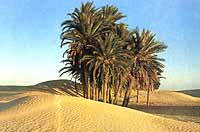
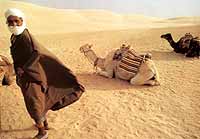
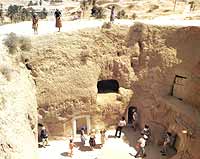
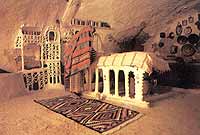
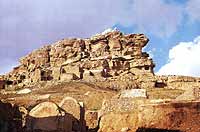
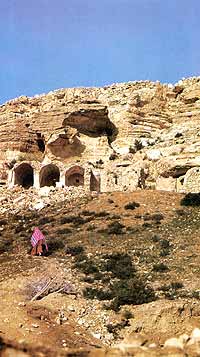
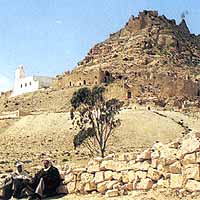
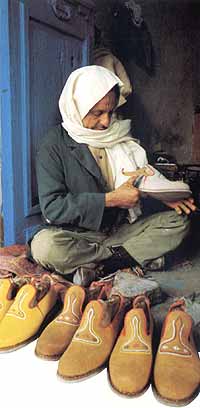
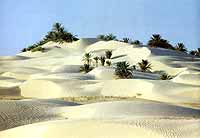
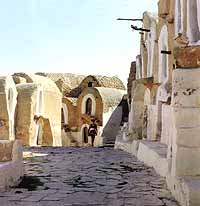
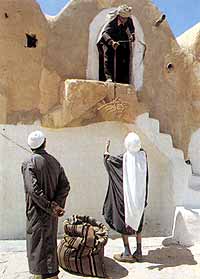
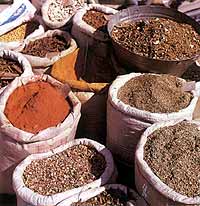
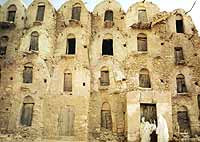
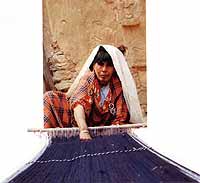
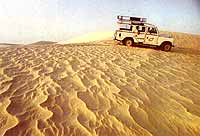

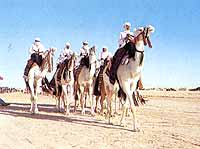
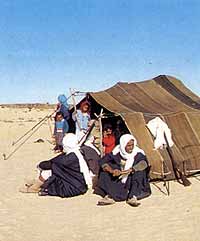
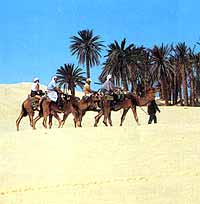
EGYPT - SYRIA - JORDAN